This edition of Riverwalk Jazz celebrates the joyful noise of trumpets and cornets in early jazz from New Orleans street bands to Swing Era ballads. Special guests Nicholas Payton, Clark Terry, “Sweets” Edison and Bob Barnard team up with our own Jim Cullum to tell the story of the Trumpet in Jazz.
The trumpet is one of the oldest of all musical instruments. Paleolithic people discovered that a loud, signaling sound could be produced by blowing air while buzzing the lips on the small opening of a conch shell or ram’s horn. Representations of trumpets have been found in hieroglyphs in ancient Egypt, and in the mountains of Tibet where trumpets were made out of thigh bones.
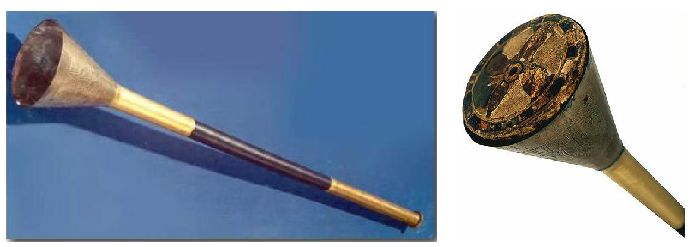
first trumpets. Photo courtesy egyptsearch.
Most ancient trumpets were long, straight instruments made of bronze, wood or even silver. These early trumpets were loud and not particularly musical. Fifth century historian Herodotus compared the sound of trumpets to the “braying of an ass.” These early instruments were usually played outdoors to excite the crowd for military parades and royal ceremonies. After the fall of Rome, the trumpet disappeared from Europe and didn’t reappear until the Crusaders brought these horns back from Turkey almost a thousand years later. Around 1400 AD craftsmen in Europe began to develop more sophisticated instruments, bending the tubing and forming slides. These innovations created a more musical sound and allowed for more control and a wider range of notes.
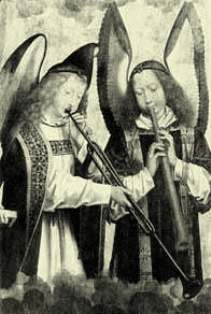
Medieval trumpets. Photo courtesy medievallifeandtimes.
By the Middle Ages, trumpets were finally brought indoors and the melodious sound of trumpet chorales filled Medieval churches. The trumpet became so popular that Renaissance nobility counted their wealth and prestige by the number of trumpeters they had in their court. By the early 17th century the trumpet was refined even more: it became easier to play in tune, and trumpet playing was finally accepted as art music. In 1721 Johann Sebastian Bach composed his spectacular Brandenburg Concerto No. 2 for a natural (valveless) “clarino” trumpet pitched in F.
In the late 18th century, with Haydn, Mozart and Beethoven all composing symphonic music, variations were made to adapt the instrument for orchestral playing. The first valved instruments were invented in 1798. In the early 19th century, the valved cornet was introduced in Paris. It quickly took prominence over the trumpet in England, Europe and the United States. It’s said that during the Civil War, in the midst of the siege of Atlanta, every afternoon the fighting came to a standstill as soldiers on both sides were mesmerized by the soulful sound of a Confederate soldier playing the cornet.
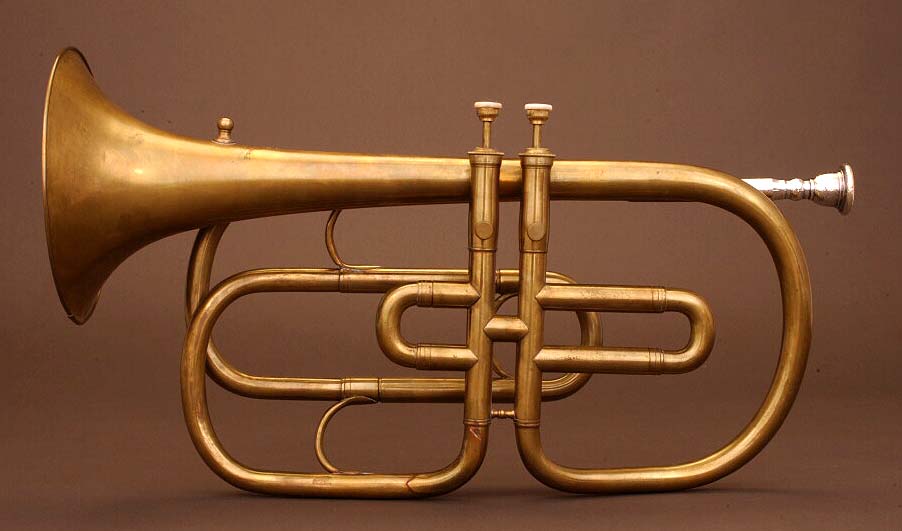
Early trumpet in F by A. G. Guichard, Paris, ca. 1840. Photo in public domain.
In 1895 John Phillip Sousa and his band were megastars of popular music. Every town in the nation had a band shell in the park featuring its own municipal band modeled on Sousa’s. Sousa was famous for hiring the top virtuoso soloists of the day, such as trombonist Arthur Pryor, euphonium player Simone Mantilla and cornetist Herbert L. Clarke. These performers were afforded enormous public adulation analogous to today’s rock stars and sports heroes.
By 1915 the trumpet and its first cousin the cornet were celebrated as the “king of instruments” in New Orleans—a city long revered for its music. The virtuosic cornet tradition of bands such as Sousa’s merged with the folk traditions of the South—African rhythms, blues, Spirituals and hymns, field songs and Spanish “banda” music. This coming together of diverse traditions gave birth to a new variety of swinging marching bands, and these sounds filled the streets of the Crescent City. Star soloists like Buddy Bolden, Bunk Johnson, Freddy Keppard and Mutt Carey vied for the title of “best of the best.”
.jpg)
Joe Oliver. Photo in public domain.
Eventually it was clear that no one could beat Joe Oliver, and he earned the title “King.” Oliver developed his style playing with the Eagle and Onward brass bands. His young protégé Louis Armstrong was proud to carry Oliver’s cornet as they paraded through the streets of New Orleans. The trend-setting jazz bands Oliver and Armstrong formed were smaller, souped-up versions of the famous New Orleans marching bands they grew up with. “Come Back Sweet Papa” by Paul Barbarin comes from this tradition. Our version this week adds Bay Area cornetist Leon Oakley and Chicago tuba player Mike Walbridge to The Jim Cullum Jazz Band.
Oliver composed “Dippermouth Blues” for his Creole Jazz Band. In 1923 he made a landmark recording in Chicago with Armstrong on second cornet. Our version starts with the original Okeh recording, then cross-fades into Jim and the expanded jazz band.
Ever since the cornet was introduced in 1798 musicians have argued over which instrument is better, the trumpet or the cornet. Sometimes the debate has become rather hot, as you can see in this letter from Herbert L. Clarke to one of his protégés in 1921:
“My Dear Mr. Benge,
“Replying to yours of the 19th just received. Would not advise you to change from cornet to trumpet, as the latter instrument is only a foreign fad for the time present. One cannot play a decent song properly on a trumpet; it pollutes the art of music. Am pleased that you are making improvements in your playing. Keep it up and become a great cornet player.
“Sincerely Yours, Herbert L. Clarke”
To help listeners decide for themselves, we present Jim Cullum on cornet and Nicholas Payton on trumpet with a Louis Armstrong-inspired slow version of “12th Street Rag.”
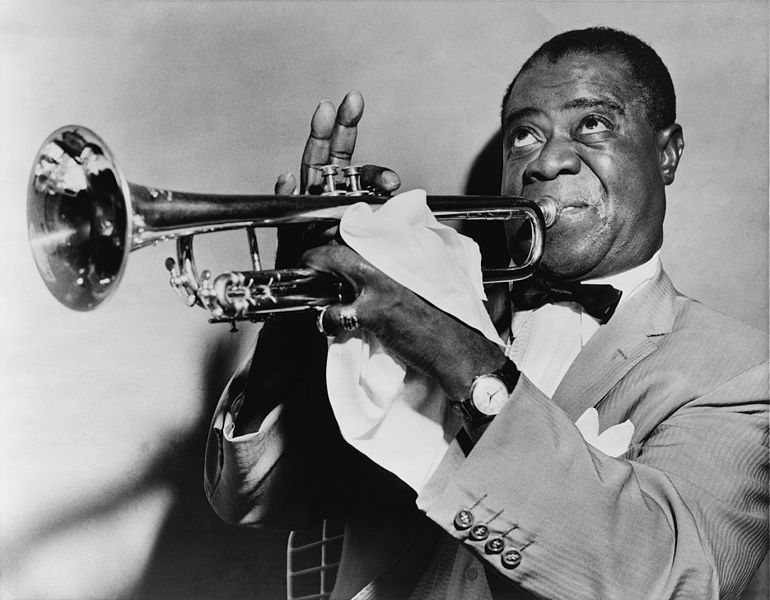
Louis Armstrong. Photo courtesy Wikimedia.
About Louis Armstrong, Jim Cullum says, “To my mind Louis remains the greatest player of the pre-bop styles. No one has overtaken his combination of technical expertise and emotional content. This is especially remarkable considering that Louis had minimal formal training and was largely self-taught.”
In Armstrong’s 1936 recording of “Swing That Music” one can hear his high note playing at its peak. Cullum says, “He had to have tremendous physical endurance and vibrant good health to achieve his level of high note playing, night after night, in the ‘30s. It is said that during his live stage show he would sometimes play 100 high Cs on one tune. Musicians would watch in awe and count each high C he played. Here, Nicholas Payton takes on “Swing That Music” and says, “It takes two musicians to come close to doing what Louis did all by himself.”
Born black and poor in a New Orleans slum in the early 1900s made basic survival for Louis Armstrong unbelievably hard. Armstrong grew up in such incredible poverty most of us can’t begin to imagine what it was like. Raised in a section of town known as “The Battlefield,” his only music lessons were picked up in the Colored Waifs Home, a combination orphanage and detention home for boys, and on the streets of the French Quarter. Armstrong managed to have a rich, happy life and a long, brilliant career. He was determined to play the best jazz on the planet and have a great time doing it; he seems to have succeeded at both.
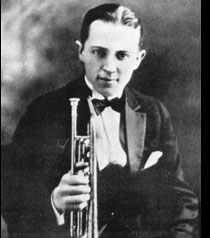
Bix Biederbecke. Photo in public domain.
Bix Beiderbecke, another legendary artist to come of age in the 1920s, couldn’t have been more different. Bix grew up in a comfortable house in the small town of Davenport, Iowa on the Mississippi River. He was white and middle class and shocked his family when he taught himself to play cornet listening to phonograph records in the parlor. His mother had hoped he would become a classical concert pianist.
Bix was sent to a private school—Lake Forest Academy near Chicago, where he failed at his lessons but advanced his education in jazz by sneaking out to spend his nights at jazz clubs, listening to King Oliver and his Creole Jazz Band and the New Orleans Rhythm Kings. Bix was a shy genius with a fatal obsession with alcohol. In the 1920s he set the jazz world on fire with his pure jazz cornet style, lyrical solos, and his inventive compositions. Although he died before reaching his thirtieth birthday, his innovative musical ideas live on in his recordings and a handful of jazz compositions. This week, Jim and the Band play “Davenport Blues,” which Bix composed in homage to his home town.
The big bands of the 1930s provided fertile ground for a new generation of jazz trumpeters. In 1936 Oran “Hot Lips” Page, billed as the “trumpet king of the West,” was one of the stars of the Count Basie Orchestra at the Reno Club in Kansas City. Born and raised in Texas, Page had spent his youth backing blues singers including Bessie Smith. His fondness for swinging blues stayed with him when he moved to New York to play in 52nd Street jazz clubs. Over the course of his career, Page made a number of hit recordings, such as “St. James Infirmary” with Artie Shaw and “Baby, It’s Cold Outside” with Pearl Bailey. Page had an amazing ability to “drive” the rhythmic feel of a band. At the height of the Boogie Woogie craze in 1944, he recorded “Jammin’ The Boogie” with pianist Albert Ammons, to which Jim and the Band along with frequent guest pianist Dick Hyman, pay tribute with a crossfade from the original.
The Duke Ellington Orchestra had a series of spectacular trumpet players. Early on Bubber Miley and the vocal-like effects he created by skillfully manipulating mutes, had a great influence on the development of the Ellington Orchestra’s signature sound. He co-wrote Ellington’s first big hit, “Black and Tan Fantasy.” Miley was followed by Cootie Williams and Rex Stewart. In the 1950s our good friend Clark Terry left his long tenure with the Basie Band to play with Duke. For our show this week, Terry and pianist John Sheridan play two tunes that Terry recorded with Ellington, “Come Sunday” and “Sophisticated Lady.” Terry plays the flugelhorn, an instrument with the same notes as the trumpet and cornet but produces a much darker sound. It was Clark Terry who pioneered the use of the flugelhorn in jazz, now a common practice among trumpeters.
Harry “Sweets” Edison was another mainstay of the Basie Band trumpet section in the 1930s and ‘40s. Sweets joins Jim and the Band on a tune he wrote that became his first hit record for Basie, “Jive at Five.”
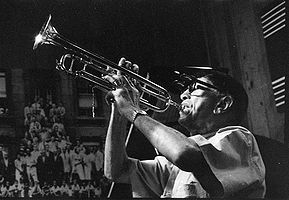
Doc Cheatham. Photo courtesy Wikimedia .
Jim Cullum explains the difference between the trumpet, cornet and flugelhorn—all usually pitched to the same key of Bb and all playing the same notes. The internal tubing shapes of the three instruments, which determine their respective sound characteristics, lie on a continuum between cone and cylinder. Of the three, the cylindrical trumpet gets the most strident and brilliant tone, whereas the conical flugelhorn’s sound is more akin to the French horn, which is the most conical of all the brass instruments. The internal shape and sound of the cornet, on the other hand, lie somewhere in between the trumpet and flugelhorn. Cullum explains his preference for the cornet and says one of his greatest thrills was performing alongside the great jazz cornetist Bobby Hackett at The Landing in San Antonio, Texas. Our tribute to Hackett is a crossfade starting with his historic recording of “I'm Comin' Virginia” from the album Bixieland and fading into Cullum’s performance with the Band, joined by Australian cornet master Bob Barnard.
To close our show, Jim and the Band are joined by yet another trumpet legend, Adolphus “Doc” Cheatham, on one of his signature tunes from the 1930s, “Zonky.”
Text based on Riverwalk Jazz script by Margaret Moos Pick ©1997

